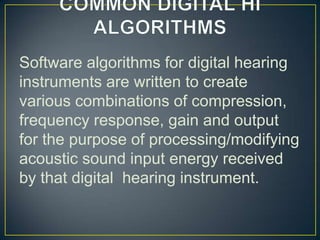
Common digital hi algorithms
- 1. Software algorithms for digital hearing instruments are written to create various combinations of compression, frequency response, gain and output for the purpose of processing/modifying acoustic sound input energy received by that digital hearing instrument.
- 2. Particular digital hearing instrument performance characteristics (which have been created by the algorithms) may then be chosen, applied and modified for appropriate stimulation of the patient/client’s residual hearing ability.
- 3. There are six fundamental algorithms written into the software for digital hearing instruments. They are: 1. Automatic feedback reduction 2. Combinations of compression types 3. Expansion 4. Dynamic noise reduction 5. Multiple channels and bands 6. In-situ audiometric testing (using the HI)
- 4. Automatic Feedback Reduction There are two basic types of feedback reduction. They are: 1. Notch filtering 2. Phase cancellation.
- 5. NOTCH FILTERS—have limitations regarding the number of peaks in the frequency response they can affect, and the decibel amount of reduction they can create within a certain few milliseconds.
- 6. PHASE CANCELLATION—involves the creation of an out-of-phase frequency signal by the digital HI processor. It’s limitations occur when it is unable to “recognize” the input sound as feedback or, more often, inappropriately recognizes the input sound and generates the phase cancellation signal when not required.
- 7. COMPRESSION TYPES Digital HI algorithms may be written for multiple configurations of compression. For example, multiple kneepoints may be integrated into one channel of processing. Let’s view Venema page #163
- 8. COMPRESSION TYPES Note: on the input/output graphs for these multiple kneepoints, all compression ratios below the 1:1 compression line represent output compression, and all compression ratios above the 1:1 line represent input compression.
- 9. COMPRESSION TYPES Most digital HI compression strategies fundamentally use SYLLABIC compression for low frequency channels and AVERAGE DETECTION compression for high frequency channels.
- 10. COMPRESSION TYPES NOTE: An interesting type of compression is Adaptive Dynamic Range compression it uses audibility and comfort criterion to automatically adjust the gain and output characteristics by input frequency. It is an attempt to electronically simulate the hair cell functions of the human cochlea.
- 11. EXPANSION Expansion is the opposite of compression. • It actually reduces gain below 40dB SPL. • This gain reduction for soft inputs was designed to eliminate the microphone and amplifier noise of digital hearing instruments.
- 12. EXPANSION • It acts like an internal noise “squelch filter”—in fact some manufacturers call it a “soft squelch” feature. • It is only “offered”/present below the left-most compression kneepoint of a digital hearing instrument.
- 13. DYNAMIC NOISE REDUCTION There are four primary types of noise reduction algorithms used within today’s digital hearing instruments. They are: 1. Spectral Subtraction 2. Phase Cancellation 3. Spectral Enhancement 4. Speech Synthesis
- 14. SPECTRAL SUBTRACTION • This type of algorithm basically attempts to differentiate the noise components of the frequency spectrum from the speech components. • It then attempts to subtract the spectral noise components from the received frequency input thereby, allowing the spectral speech components to remain and become enhanced/amplified.
- 15. PHASE CANCELLATION • This algorithm design identifies spectral noise and then creates an opposite spectral phase signal to cancel the noise. • It is the fundamental process used in the BOSE noise cancelling headphones. • NOTE: The input to a hearing instrument already has the speech and noise mixed so, it cannot operate like a BOSE noise cancellation headset.
- 16. SPECTRAL ENHANCEMENT • Once again, this type of algorithm basically attempts to separate the noise components of the frequency spectrum from the speech components. • However, its premise is to increase the reception of the spectral components of speech. • This enhanced signal should provide a greater opportunity to differentiate speech
- 17. SPEECH SYNTHESIS • This type of algorithm has a similar performance to the spectral enhancement algorithm. • However, it takes the identified spectral speech input components, and adds additional (and similar) spectral information to the input of the digital amplifier.
- 18. SPEECH ENHANCEMENT & DNR Let’s view Venema page #175 • These two spectral intensity graphs represent an acoustic input signal into a digital algorithm. • You can see that when spectral intensities do not fluctuate over a defined time period, the algorithm determines that input to be noise and that spectral input is reduced. • If the spectral intensities do fluctuate over
- 19. SPEECH ENHANCEMENT & DNR • There is a lot of variation in the DNR algorithm effectiveness among the various manufacturers. • It is the generally accepted wisdom today, that there is no objective benefit for improved speech recognition within background noise.
- 20. • Perhaps there is not quantifiable objective benefit because the patient/client’s ability to perform that hearing-in-noise activity has not been measured? • You will learn more about patient/client speech-in-noise residual ability performance assessments in HIS 230.
- 21. MULTIPLE CHANNELS & BANDS • All digital algorithms involve multiple channels and bands to create the desired performance characteristics of that specific algorithm. • The more compression channels that are available, the greater the opportunity to create custom algorithms for patient/client psycho-social demands. • Remember, you can have more bands than channels to create algorithms, so multiple algorithms may be created off of
- 22. IN-SITU AUDIOMETRY • Many of today’s digital hearing instruments can generate their own electroacoustic signal without any outside acoustic input. • This provides the dispensing professional the opportunity to measure the patient/client’s residual hearing ability as modified by the insertion of a digital hearing instrument. • Pure tone threshold and supra-threshold
- 23. • It is interesting to observe the departure from a required knowledge of compression types and other technological features on the part of the dispensing professional. • The current trends appear to be more toward the psycho-social issues of the patient/client. • Minor compression and other electro- acoustic settings appear to depend more on creating specific answers to patient/client psycho-social situations and
